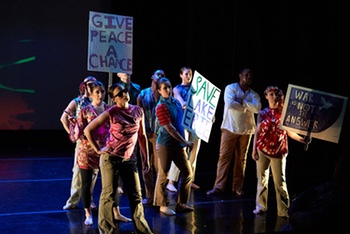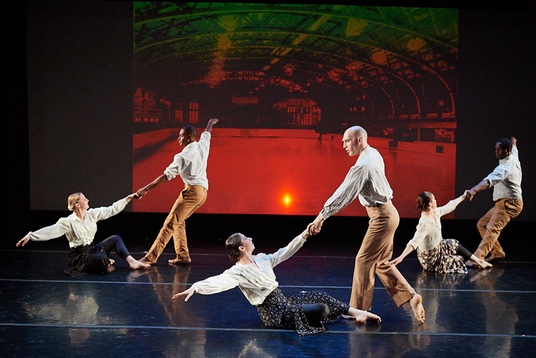Fri 12/21 @ 7:30PM
Inlet Dance Theatre’s latest project, Building CLE, is an evening-length, multimedia performance piece derived from the stories of residents of Judson Manor and Judson Park, and how they played their part in building Cleveland. It sounded interesting to us so, to learn more, we watched a rehearsal and talked with Inlet founder and executive/artistic director Bill Wade on the phone.
CoolCleveland: So we’re here to talk about the premiere of Building CLE.
Bill Wade: Yes, it’s finally… it will be finished!
CC: We understand that you already performed parts of this piece at Cleveland Public Theater (CPT).
BW: Yes, we’ve been on a two-and-a-half-year journey with our friends at Judson Manor and Judson Park. We received funding from the Ohio Arts Council’s (OAC) Creative Aging Initiative, which is about sharing your art with other people, particularly aging Ohioans. OAC kind of called me because they knew I was interested in creating art with elderly people. Actually, the first commission I ever had with Inlet was from the Long Term Care Ombudsman of Greater Cleveland. They gave me stacks of research, stories, with people’s names blacked out and that was the beginning of our piece Memoriate (2001). We performed Memoriate at Judson Park along with a few other pieces. Gathering critical feedback after the performance, we realized it had a pretty large impact.
CC: So Building CLE is an extension of the idea behind Memoriate?
BW: Yes, but we’re allowing the Judson residents a great deal of input. We know that we can do the Thinker, Bridges, Snow, so we develop that material in the studio and show them videos of what we’ve done and they say, “You have to do this, you have to do that.”
CC: Honest to God, Bill! You let them see your video rushes? Then you incorporate their ideas? You let them pick at your work?
BW: It’s our work. One of the things we do frequently at Inlet is we make work that is by, with and for the people we’re working with, specific populations. We’re saying to them, this isn’t about us giving you a movement class so you feel like you’ve had your exercise today. This is about reengaging your life story with the creative arts so that we actually end up with a performative product and so that your life story becomes something that’s performed on stage. And teaching you something about what it means to be a choreographer.
Of course, we also have to pay attention to composition, music choice, costuming that helps carry the narrative. Building CLE has turned into a multimedia thing with sound collage and video collage where I have to learn software and video editing.
CC: Who’s your tech person for the projections?
BW: Me.
CC: Good luck! That stuff is hard. Although we have seen productions where the projections came out well. We just watched Dancing Wheels do it and Neos Dance has done a number of things with projections.
BW: Video editing is not something I saw coming but I’m learning it because I had to. But on all of this you have to keep your composition eye going.
When we put it onstage at CPT in 2017 we thought it was pretty cool. It had seven sections, projections. But we ran it first in the concert that year because frankly we didn’t know how strong it would be. The entire audience jumped to their feet and it was really loud. That’s when we realized, Cleveland is proud of Cleveland now. When the run at CPT was over, the people at Judson informed Inlet, “We’re not done. This needs to be a full-length piece.”
CC: How long is it?
BW: Well, we’re not done. It’s going to be about an hour. We had to go back to OAC and thank the Lord they said “Yes.” They were really excited. They were like, Inlet is the only one of the Creative Aging cohort that actually got the people involved in the art-making process and put something on stage.

CC: Yes, your work on Building CLE does sound unusual. We were thinking earlier of a similar piece by Dianne McIntyre, Dancing Memories: Lost & Found. Like you, she interviewed elders but unlike you she went off by herself to edit their stories and structure the piece. We can’t imagine doing what you did with the Judson residents.
BW: There’s this one section on the GI Bill, which was a big topic for several of them. We were showing them the choreography, and one of them got really upset because there were no books involved. Going to school you have to have books, right? Well, how might we do that? Let’s honor your idea. So we found a way to do it and she loved it. (Speaking in falsetto) “You took my book idea and you put it on stage.”
We had a day where we bussed them down to the studio and showed them the rough drafts of the choreography and had a big session afterwards. This fall we took them to the Cleveland History Center, which covers a lot of the same ground as Building CLE. We paired them up with the 18 dancers, walking through the exhibit and recording their reactions on our phones. The items at CHC are great memory joggers. So it’s been really, really fun. Super challenging, I’m not going to lie. But people who work with the Judson residents say they’re really involved. When they start talking about it they wake up.
CC: Your process was even more labor intensive than we realized. But that engagement you describe is priceless.
Building CLE takes place at Near West Theatre in Gordon Square. Tickets are $15, available online or at the door.
[Written by Elsa Johnson and Victor Lucas]

